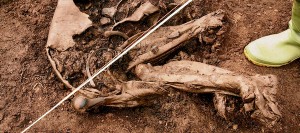 The operator of a turf-milling machine uncovered human remains in the Cul na Móna bog near Portlaoise, County Laois, Ireland, this past Wednesday evening. The Bord Na Móna (the semi-public Peat Board responsible for harvesting Irish peat resources) employee saw the remains poking through the surface just before he drove the machine over the spot. As all Bord Na Móna workers are thoroughly trained in how to handle potential historic artifacts, he stopped and alerted the company which alerted the National Museum of Ireland.
The operator of a turf-milling machine uncovered human remains in the Cul na Móna bog near Portlaoise, County Laois, Ireland, this past Wednesday evening. The Bord Na Móna (the semi-public Peat Board responsible for harvesting Irish peat resources) employee saw the remains poking through the surface just before he drove the machine over the spot. As all Bord Na Móna workers are thoroughly trained in how to handle potential historic artifacts, he stopped and alerted the company which alerted the National Museum of Ireland.
Two naturally mummified legs were found sticking out of a leather bag. It’s thought that the torso and head decayed over thousands of years inside the bag, but the legs, directly in contact with the peat bog’s acidic water, cold temperatures and lack of oxygen, were preserved. The bog mummification process tans the skin, darkening it and giving it a leathery texture.
Ned Kelly, Keeper of Irish Antiquities at the National Museum, notes that the body was deliberately deposited on that location. It wasn’t an unfortunate accident — bog bodies have been found grasping at branches as if trying to pull themselves out of a swampy pool — and Kelly thinks in all likelihood the body was ritually deposited as a human sacrifice. Initial examination of the remains suggest the person died between 2,000 and 3,000 years ago.
“We can’t tell if it is Iron Age, but it has been found on an ancient tribal boundary, a characteristic of other finds of Iron Age date,” [Kelly] said.
He said burying bodies on tribal boundaries was “an observed practice” during the Iron Age and this body did seem to fit to that description, though it was too early to be certain.
Museum staff were excited to have the chance to examine a bog body discovered in situ. Most of the time it’s turf-cutting that churns up finds and thus archaeologists don’t have the chance to examine them in context. Since they know exactly where the body was found, they can also examine a nearby mound which contains peat from the same area to recover any other human remains that might have wandered off.
As soon as possible, the body will be taken to the National Museum in Dublin for radiocarbon dating to determine its age and osteological analysis to determine its gender.
There is some excellent footage of the find in situ here. (Protip: the bog looks like an agricultural field, not like the swampy wetland of my imagination.)